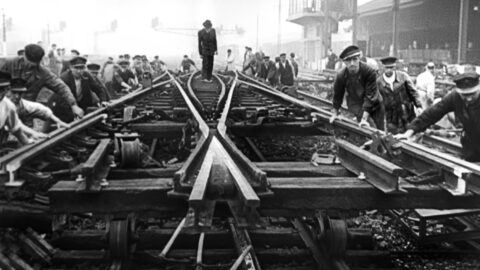Whether it’s the unmistakable images of the iconic short film The Arrival of a Train at La Ciotat Station (Auguste and Louis Lumière, 1896), the lovers departing at Milford railway station in Brief Encounter (David Lean, 1945) or the young conductor bamboozled by the tides of history and his own heart in Czech classic Closely Observed Trains (Jiří Menzel, 1966), there’s something particularly cinematic and evocative about travelling and meeting people by rail.
And while the world has changed in many ways, and trains have gotten significantly faster, the basic principles of train travel are more or less the same — still holding the residue of that initial romance promised nearly 200 years ago.
But there is a dark side to this incredible technology, which has been used for evil as much as for good. For all the people discovering themselves through Interrail (I’m people), the train can also be used as a weapon of war, transporting soldiers and armies to the frontlines; as well as a tool of death, shipping millions of Jews, as well as other minorities, to their deaths during the Holocaust.
In the powerful, if repetitive, Trains (2024) — winner of the top prize at IDFA last year — director Maciej J. Drygas pulls footage from tens of different archives, creating a reverie on how this transformative mode of transportation shaped the course of the 20th century.
It starts with the trains being made in a factory in Britain before they are wheeled out around Maidenhead. From there, across the United Kingdom, France, Germany — and most notably Poland — Drygas shows us endless footage of people either standing on platforms, getting onboard, dining in the restaurant car or staring out of the window. And there are many jolly moments, including footage from Charlie Chaplin’s The Idle Class (1921). 1Don’t expect a montage including The General (Buster Keaton, 1996) or The Fugitive (Andrew Davis, 1993), though. This film is far more subtle in its use of classic footage than you might anticipate.
But the tone turns noticeably darker once we dive into the war footage, the train’s enormous logistical capacities one of the key reasons the First and Second World Wars were unlike any the world had previously seen. Tank after tank rolling across the plains2It reminded me of when I was in Russia and there was a train at least a mile long with just army equipment on it. In many ways, nothing has changed.; Jews bundled into a train, some hanging off the windows; army men awkwardly crammed right into each other. Suddenly, something so capable becomes the executor of monstrous, unfathomable ideas.
With no dialogue and no narration, all the editorialising comes through the images and their relationship to one another, as well as the intense music score by Paweł Szymański, combining electronica with minimalism in an effective feature-length ambient panic attack. Sometimes you even hear strange noises and sounds, like the ghosts of history are trying — and failing — to tell us something. It represents a monumental effort in archival effort as well as compressing hours of footage into a single, fleet and haunting viewing. It makes a fascinating comparison piece with Shoah (Claude Lanzmann, 1985), also presented at this festival, and also terrified by the machinery of death. As new technologies keep emerging in the 21st century — the iPhone, AI, Virtual Reality — the lessons of what to do with tools of extraordinary societal change feel more potent than ever.
Redmond is the editor-in-chief of Journey Into Cinema.

